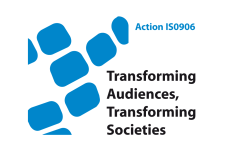- About the Action
- Events
- PhD workshop - Ljubljana 2014
- Action Open Conference - Ljubljana 2014
- New Media and Participation conference - Istanbul 2013
- Belgrade meeting 2013
- Media literacy research and policy - Brussels 2013
- ICA Pre-Conference 2013
- Tampere meeting 2013
- Budapest workshop 2012
- Milan meeting 2012
- Brussels PhD workshop 2012
- Brussels Action workshop 2012
- London meeting 2011
- Zagreb Conference 2011
- Lisbon meeting 2010
- Affiliated events
- WG 1
- WG 2
- WG 3
- WG 4
- Cross-WG
- Output
Public Service Media Radio 2.0 ahead
Jedrzejewski, S. (2013). Public Service Media Radio 2.0 ahead. , 39-54Lublin: Curie-Sklodowska University Press.
Abstract: Today, we are witnessing mediamorphosis including two simultaneous waves: the transition from analogue to digital and the transition to information technology (IT). This applies to all operations performed adequately on the information: the collection and storage, processing and distribution. All are taking place now in digital technology, in terms of convergence of classical radio and television, telecommunications and IT. In other words - through a combination of attributes as well as radio and television, phone and computer. Making the technological revolution is so profound that we are talking today about the twilight of the "old" print and electronic media and the emergence of the "new". The critical point in the evolution of the new media and the internet dissemination sits in the 90s of the twentieth century, because it is the internet - a medium, yet powerful information resource – that is a kind of essence of the new realities of technology and media. In the radio broadcasting, there is no unique and inevitable future which can be prescribed in advance. It can however identify trends and tendencies, as a snapshot of the dynamic development. At this moment technology is one of the most important factors of radio development. The technology changes accelerate with the growing use of digital technology. As the EBU Digital Strategy Group II states it: “Digital technology makes possible new ways to produce and deliver media, and brings a wider use of ever more sophisticated multimedia, interactivity, the option of multi-channel services, in-demand services, and the availability of different picture and sound quality options”( Digital Strategic Group II Report, 2006). Radio broadcasters began, by simulcasting their existing stations but soon realized the value of internet – only as brand extension. Globally it is estimated that there are now over 500.000 internet radios with 70 million listeners (Lansmann, 2010). The paper is able to search which strategies and possibilities are to choose for radio broadcasters in these circumstances in terms of transmission technology, content, and audiences’ behaviours.

